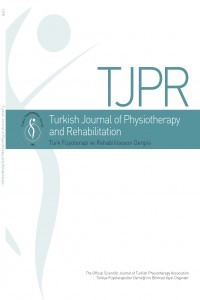Farklı servikal bölge izometrik egzersiz tiplerinin karşılaştırılması
Servikal vertebra, Egzersiz; izometrik, Elektromyografi
Comparison of different types os isometric exercises in the cervical region
Cervical vertebrae, Exercise; isometric, Electromyography,
___
- Moroney SP, Schultz AB, Miller JAA. Analysis and measurement of neck loads. J Orthop Res. 1988;6:713–720.
- Mayoux BMA, Revel M, Vallee C. Surface electrodes are not appropriate to record selective myoelectric activity of splenius capitis muscle in humans. Exp Brain Res. 1995;105:432–438.
- Keshner E, Campbell D, Katz R, et al. Neck muscle activation patterns in humans during isometric stabilization. Exp Brain Res. 1989;75:335–344.
- Schuldt K, Ekholm J, Harms-Ringdahl K, et al. Influence of sitting postures on neck and shoulder emg during arm–hand work movements. Clin Biomech. 1987;2:126–139.
- Schuldt K, Ekholm J, Harms-Ringdahl K, et al. Effects of changes in sitting work posture on static neck and shoulder muscle activity. Ergonomics. 1986;29:1525–1537.
- Villanueva MB, Jonai H, Sotoyama M, et al. Sitting posture and neck and shoulder muscle activities at different screen height settings of the visual display terminal. Ind Health. 1997;35:330–336.
- Lannersten L, Harms-Ringdahl K. Neck and shoulder muscle activity during work with different cash register systems. Ergonomics. 1990;33:49–65. T, 17. Shirado O, Ito Kaneda K, et al. Electromyographic analysis of four techniques for isometric trunk muscle exercises. Arch Phys Med Rehabil. 1995;76:225-229.
- De Luca CJ. The use of surface electromyography in biomechanics. J Appl Biomech. 1997;13:135-163.
- Westgaard RH. Muscle activity as a releasing factor for pain in the shoulder and neck. Cephalalgia 1999;(19 Suppl. 25):1-8.
- Winter DA, Fuglevand AJ, Archer SE. Cross-talk in surface electromyography: theoretical and practical estimates, J Electromyography Kinesiol. 1994;4:15– 26.
- Cram JR, Kasman GS. Introduction to Surface Electromyography, Aspen Publishers, Gaithersburg. 1998.
- Giroux B, Lamontagne M. comparison between surface electrodes and intramuscular wire electrodes in Electromyography and Clinical Neurophysiology. 1990;30:397–405 dynamic conditions.
- Ylinen JJ, Hakkinen AH, Takala EP, et. al. Effects of neck muscle training in women with chronic neck pain: one-year follow-up study. J Strength Cond Res. 2006;20:6–13.
- Ekstrom RA, Soderberg GL, Donatelli RA. normalization procedures using maximum voluntary isometric contractions for the serratus anterior and trapezius muscles during surface EMG analysis. J Electromyography Kinesiol. 2005;15:418–428.
- Edmondston SJ, Sharp M, Symes A, etal. Changes in mechanical load and extensor muscle activity in the cervico-thoracic spine induced by sitting posture modification. Ergonomics. 2011;54:179-186.
- Chiu TTW, Lam T.H, Hedley AJ. Maximal Isometric muscle strength of the cervical spine in healthy volunteers. Clin Rehabil. 2002;16;772-779.
- Hawkes DH, Alizadehkhaiyat O, Fisher AC, et al. Normal shoulder muscular activation and co- ordination during a shoulder elevation task based on activities of daily living: an electromyographic study. J Orthop Res. 2012;30:53-60.
- Kumar S, Prasad N. Cervical EMG profile differences between patients of neck pain and control. Disabil Rehabil. 2010;32:2078-2087.
- Jordan A, Bendix T, Nielsen H, et al. Intensive training, physiotherapy, or manipulation for patients with chronic neck pain: a prospective, single-blinded, randomized clinical trial. Spine. 1998;23:311–319.
- Fernández-de-las-Peñas C, Falla D, Arendt-Nielsen L, et al. Cervical muscle co-activation in isometric contractions is enhanced in chronic tensiontype headache patients. Cephalalgia. 2008;28:744–751.
- Farshadmanesh F, Byrne P, Keith GP, et al. Cross- validated models of the relationships between neck muscle electromyography and three-dimensional head
- Neurophysiol. 2012;107:573-590. gaze behavior. J
- ISSN: 2651-4451
- Başlangıç: 1974
- Yayıncı: Türkiye Fizyoterapistler Derneği
Yaşlılarda fiziksel aktivite ile uyku kalitesi arasındaki ilişki
Baş dönmesi şikayeti olan bireylerde baş dönmesi süreğenliği ile depresyon ilişkisinin incelenmesi
Ampute milli futbol takımının beslenme durumu ve antropometrik ölçümlerinin değerlendirilmesi
Gebelik sürecinde zaman mesafe parametreleri ve plantar basınç dağılımı
Farklı servikal bölge izometrik egzersiz tiplerinin karşılaştırılması
Diz altı amputelerde farklı postoperatif ödem kontrol yöntemlerinin etkinliğinin karşılaştırılması
